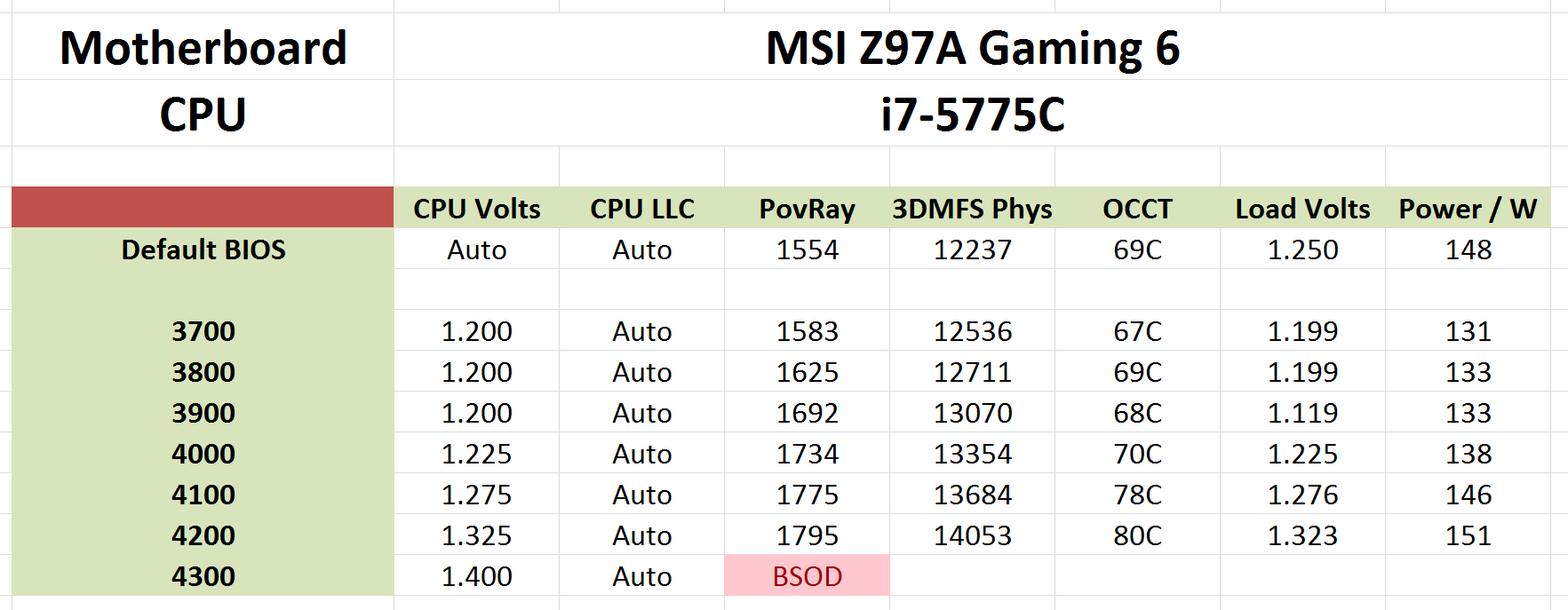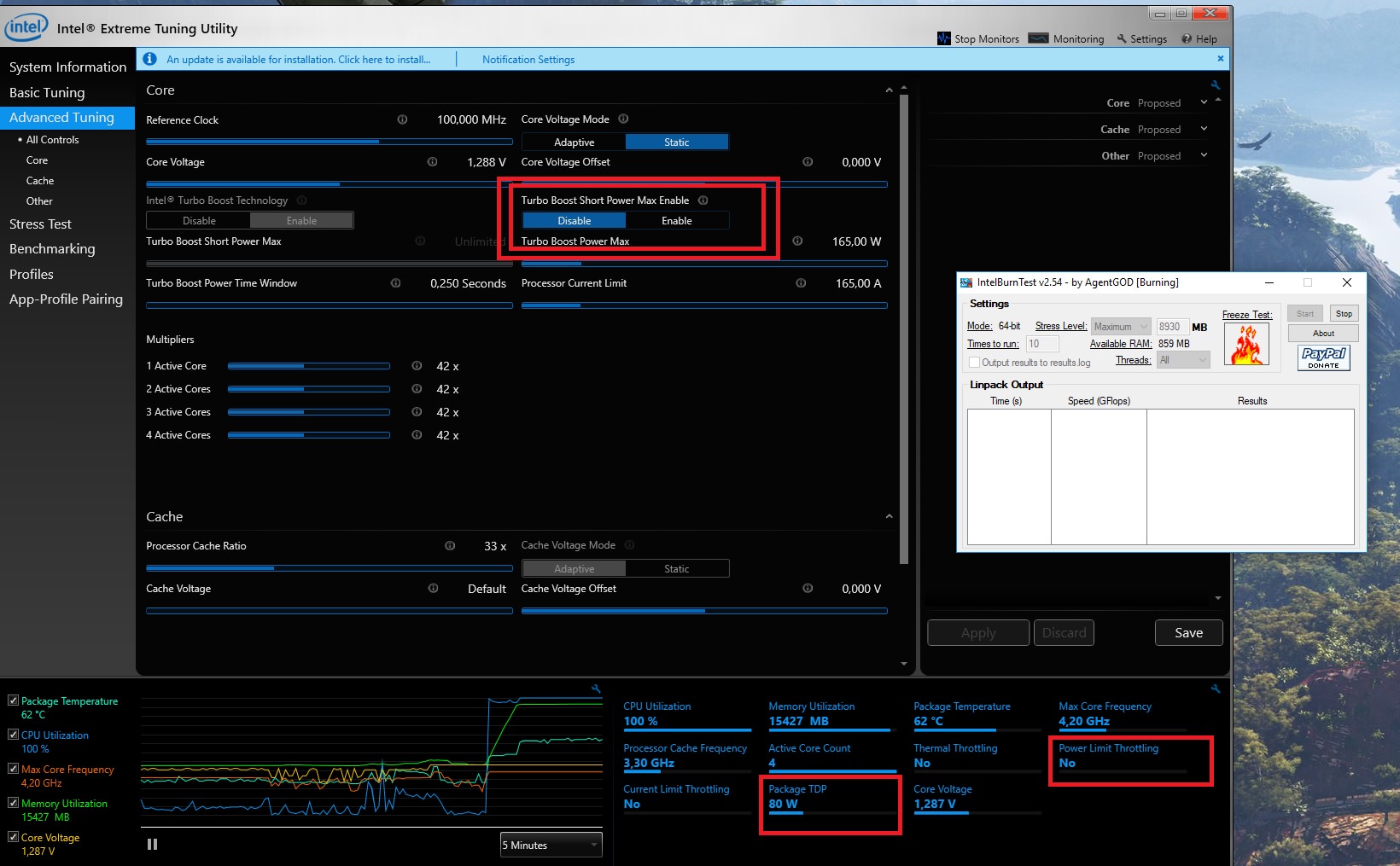- Joined
- Feb 22, 2009
- Messages
- 786 (0.13/day)
| Processor | Ryzen 7 5700X3D |
|---|---|
| Motherboard | Asrock B550 PG Velocita |
| Cooling | Thermalright Silver Arrow 130 |
| Memory | G.Skill 4000 MHz DDR4 32 GB |
| Video Card(s) | XFX Radeon RX 7800XT 16 GB |
| Storage | Plextor PX-512M9PEGN 512 GB |
| Display(s) | 1920x1200; 100 Hz |
| Case | Fractal Design North XL |
| Audio Device(s) | SSL2 |
| Software | Windows 10 Pro 22H2 |
| Benchmark Scores | i've got a shitload of them in 15 years of TPU membership |
I've been testing my Core i7 5775C to find it's real maximum performance.
My aim was to find out the maximum working frequency at which the CPU would never throttle. That includes fining the optimal bios settings and voltage too.
Let's start with the fact, that Core i7 5775C is the only Intel 8 thread desktop CPU that can reach 4 GHz at 65W TDP without any additional voltage. If anyone knows any other desktop CPU that does 4 GHz at no more than 65W, please indulge me. This is achieved by simply having turbo boost set at 4 GHz to all cores. It will not go above 4 GHz without additional voltage.
Still though, 4 GHz is not enough these days to provide ''support'' for testing powerful video cards. What we do? Add voltage to vcore, pll, and ring (if needed), and then add frequency either by raising the turbo boost multi (base clock keep to default 33X) or raise the base clock (turbo boost disabled). The problem is that this CPU has a self defense mechanism, that ignores BIOS settings and throttles frequency down whenever power requirements exceed it's written limits.
I overclocked Core i7 5775C to 4.5 GHz with 1.38 V vcore, 1.9 V PLL and 1.2 V vring. C states, EIST and thermal monitor were disabled. Still, once i loaded CB R15 and Prime95, the CPU would actually throttle real bad - to 3.7 GHz in CB R15 and to a pathetic 2.4 GHz in Prime95... 4.5 GHz was good only at idle, or on ''paper'' like we like to say...
I did not understand what causes this throttling, since i enabled the power limit from 65 W to 150 W and miliamps from 95 to 200. I figured out the CPU ignores all the bios settings, and has some kind of internal voltage or heat threshold, so i stared experimenting.
I came to the very precise point of finding that 1.31 volts is the maximum voltage at which the CPU would not throttle no-mater what frequency is set to all cores. 4.3 GHz OC at 1.31 volts crashes BSOD during stress test. 4.2 GHz OC at 1.31 volts seems to be stable and does not throttle - the cores are at 4200 MHz during the whole CB R15 run, with occasional two cores drooping to 4100 MHz for a couple of times. If i set the vcore at 1.32 volts, the clocks would drop from 4.2 to 4 GHz half of the test time. If i set the vcore at 1.35 volts, the clocks would drop from 4.2 to 3.8 GHz most of the test time. At 1.38 volts, the clocks would be at 3.6 GHz almost the whole time - you get the picture now - the more vcore, the more throttle... I have not still found what is the lowest voltage at which the CPU can run stable 4200 MHz on all cores without drooping.. But with 1.31 volts, the temps are still nice.
That means, that 4.2 GHz is the real max speed of this CPU. More are possible, but in real life you won't see them in action due to throttling. Still, 4.2 GHz overclock is not bad, considering it's base frequency is only 3.3 GHz - it's actually solid, although, come to think of it, this is not the CPU for overclocking...

An example of Core i7 5775C 4.2 GHz OC running at 1.32 vcore - occasional drops to 4.1 GHz were noticed. The CPU cooler used was a budget single tower, so better temps should be expected with a twin tower.
My aim was to find out the maximum working frequency at which the CPU would never throttle. That includes fining the optimal bios settings and voltage too.
Let's start with the fact, that Core i7 5775C is the only Intel 8 thread desktop CPU that can reach 4 GHz at 65W TDP without any additional voltage. If anyone knows any other desktop CPU that does 4 GHz at no more than 65W, please indulge me. This is achieved by simply having turbo boost set at 4 GHz to all cores. It will not go above 4 GHz without additional voltage.
Still though, 4 GHz is not enough these days to provide ''support'' for testing powerful video cards. What we do? Add voltage to vcore, pll, and ring (if needed), and then add frequency either by raising the turbo boost multi (base clock keep to default 33X) or raise the base clock (turbo boost disabled). The problem is that this CPU has a self defense mechanism, that ignores BIOS settings and throttles frequency down whenever power requirements exceed it's written limits.
I overclocked Core i7 5775C to 4.5 GHz with 1.38 V vcore, 1.9 V PLL and 1.2 V vring. C states, EIST and thermal monitor were disabled. Still, once i loaded CB R15 and Prime95, the CPU would actually throttle real bad - to 3.7 GHz in CB R15 and to a pathetic 2.4 GHz in Prime95... 4.5 GHz was good only at idle, or on ''paper'' like we like to say...
I did not understand what causes this throttling, since i enabled the power limit from 65 W to 150 W and miliamps from 95 to 200. I figured out the CPU ignores all the bios settings, and has some kind of internal voltage or heat threshold, so i stared experimenting.
I came to the very precise point of finding that 1.31 volts is the maximum voltage at which the CPU would not throttle no-mater what frequency is set to all cores. 4.3 GHz OC at 1.31 volts crashes BSOD during stress test. 4.2 GHz OC at 1.31 volts seems to be stable and does not throttle - the cores are at 4200 MHz during the whole CB R15 run, with occasional two cores drooping to 4100 MHz for a couple of times. If i set the vcore at 1.32 volts, the clocks would drop from 4.2 to 4 GHz half of the test time. If i set the vcore at 1.35 volts, the clocks would drop from 4.2 to 3.8 GHz most of the test time. At 1.38 volts, the clocks would be at 3.6 GHz almost the whole time - you get the picture now - the more vcore, the more throttle... I have not still found what is the lowest voltage at which the CPU can run stable 4200 MHz on all cores without drooping.. But with 1.31 volts, the temps are still nice.
That means, that 4.2 GHz is the real max speed of this CPU. More are possible, but in real life you won't see them in action due to throttling. Still, 4.2 GHz overclock is not bad, considering it's base frequency is only 3.3 GHz - it's actually solid, although, come to think of it, this is not the CPU for overclocking...

An example of Core i7 5775C 4.2 GHz OC running at 1.32 vcore - occasional drops to 4.1 GHz were noticed. The CPU cooler used was a budget single tower, so better temps should be expected with a twin tower.
Last edited:





 Its a mistake to think CFL isn't a step forward other than Intel just fusing on two extra cores, there is an efficiency jump in here as well.
Its a mistake to think CFL isn't a step forward other than Intel just fusing on two extra cores, there is an efficiency jump in here as well.